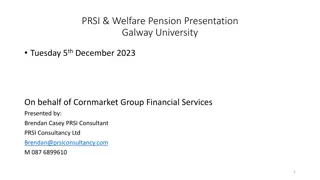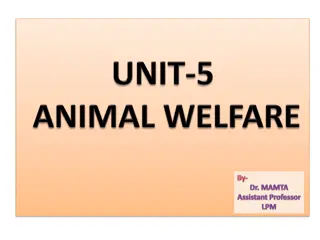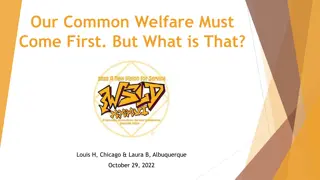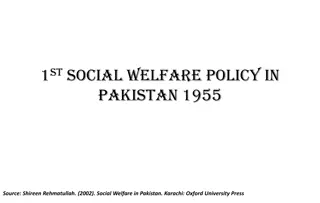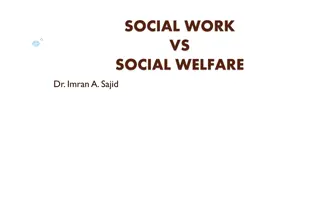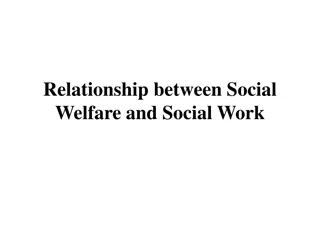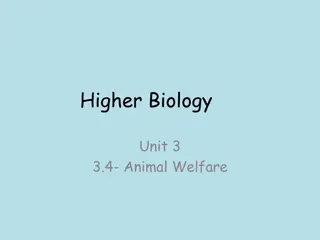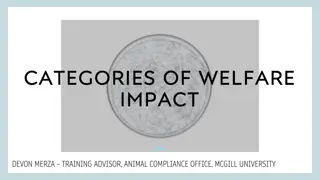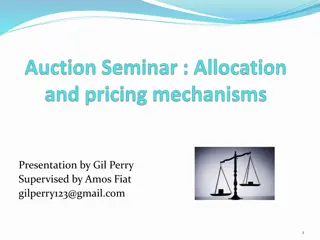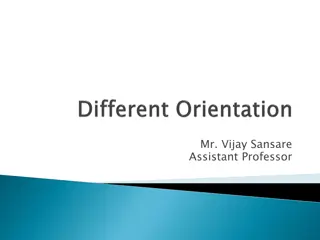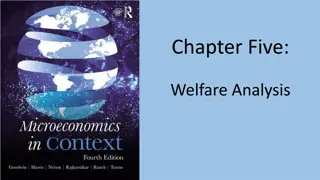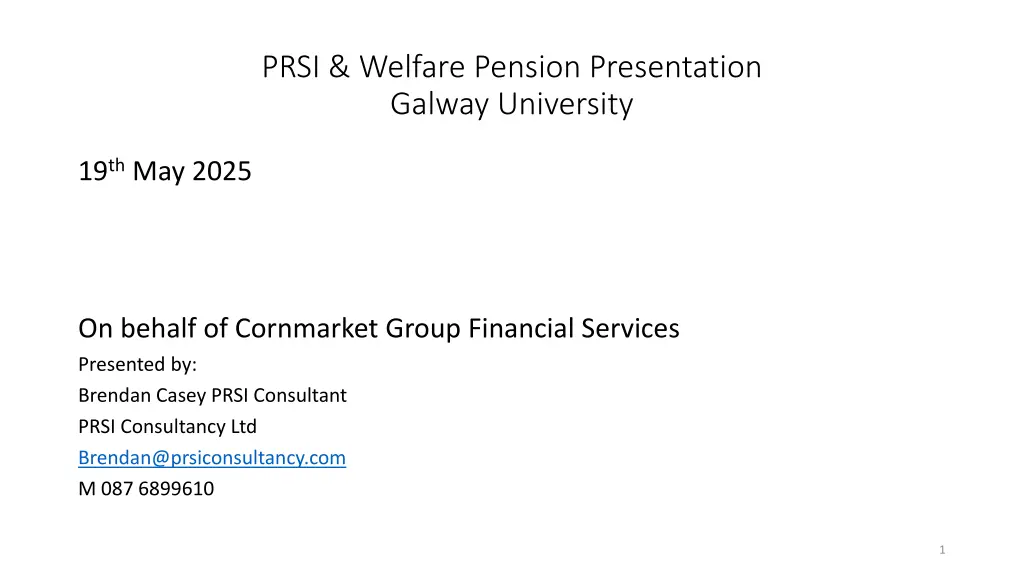
Public Service Superannuation and Pension Overview
Learn about the categories of public servants for superannuation purposes, including pre- and post-1995 classifications, entitlements to state pensions, and survivor benefits. Understand the implications of PRSI classes on pension integration and Social Welfare entitlements for retired public servants. Discover qualifications for a reduced Mixed Insurance Pro-Rata Social Welfare Contributory Pension post-retirement.
Download Presentation

Please find below an Image/Link to download the presentation.
The content on the website is provided AS IS for your information and personal use only. It may not be sold, licensed, or shared on other websites without obtaining consent from the author. If you encounter any issues during the download, it is possible that the publisher has removed the file from their server.
You are allowed to download the files provided on this website for personal or commercial use, subject to the condition that they are used lawfully. All files are the property of their respective owners.
The content on the website is provided AS IS for your information and personal use only. It may not be sold, licensed, or shared on other websites without obtaining consent from the author.
E N D
Presentation Transcript
PRSI & Welfare Pension Presentation Galway University 19thMay 2025 On behalf of Cornmarket Group Financial Services Presented by: Brendan Casey PRSI Consultant PRSI Consultancy Ltd Brendan@prsiconsultancy.com M 087 6899610 1
For Superannuation purposes there are 3 principal categories of Public Servants 1. Employed Pre-April 1995 Permanent or Temp and eventually Permanent. Pays PRSI @ Class D 1. Employed after 6th April 1995 and prior to 31st December 2012 who, on retirement will have a superannuation pension integrated with Welfare entitlements. Pays PRSI @ Class A 2. Took up employment in the public service since 1st January 2013 who, on retirement will have a superannuation pension that s not integrated with a Welfare entitlement. Pays PRSI @ Class A 2
1. Public Servant employed pre-6th April 1995 (PRSI @Class D) PRSI @Class D does not cover entitlement to the State Pension Contributory, Class D does give cover the Survivors Contributory Pension a.k.a. Widows or Widowers pension From April 2024 the Survivors Contributory Pension is payable to a surviving partner of a couple who, though not married, had been living together for at least 2 years and have had a child From April 2024 the Survivors Contributory Pension is payable to a surviving partner of a couple who, though not married, had been living together for at least 5 years 3
1. Public Servant employed pre-6th April 1995 (PRSI @Class D) Class D employee is exempt from paying PRSI @Class A on concurrent employment (pays Class J) or PRSI @Class S on self-employment (pays Class K) No entitlement to Job Seekers Benefit after retirement Assuming at least 40 years in Public Service, you or your spouse retain a guaranteed entitlement to a Survivors Contributory Pension if and when one predeceases the other. If you are divorced and have not remarried or are not cohabitating, you are still entitled to claim Survivors Contributory Pension if your ex dies, irrespective of them having remarried. If your application is late, you will be paid up to 6 months back money 4
1. Public Servant employed pre-6th April 1995 (PRSI @Class D) Retired Public Servant who had been paying the Class D rate of PRSI can still qualify for a reduced Mixed Insurance Pro-Rata Social Welfare Contributory Pension if they have a total of 260 weeks (5 years) of reckonable PRSI contributions paid before claiming the Welfare pension (between age 66 and 70) Pension reckonable PRSI Classes are A, E, F, G, H, N and S 5
Pre-April 1995 retiree: Welfare Dos and Donts Don t immediately sign on at the nearest Intreo office (Employment Exchange) because, having been previously been insured @ Class D rate of PRSI, the Credits they will award will only give cover for the Survivors Contributory Pension Don t apply to become a Voluntary Contributor because they will admit you as a VC that only covers the Survivors Contributory Pension 6
Pre-April 1995 retiree: Welfare Dos and Donts Do request a copy of your Social Welfare Insurance record which will show all weeks of PRSI contributions paid and credited prior to your employment in the public sector. Copy can be requested online if registered with MyGov.ie or Lo Call 0818 690 690 from Welfare s PRSI Records Section in Buncrana, Co Donegal 7
Pre-April 1995 retiree: Welfare Dos and Donts If you already have at least 260 weeks of reckonable PRSI Contributions Paid (credits don t count for this condition) you will qualify for a Mixed Insurance Pro-Rata State Pension Contributory at age 66 If you have potential to get 520 weeks of reckonable PRSI Contributions Paid before age 66 you will qualify for a reduced regular State Pension Contributory at age 66 8
Pre-April 1995 retiree: Welfare Dos and Donts If you are short of the 260 weeks of PRSI Contributions Paid for a Mixed Insurance Pro-Rata State Pension Contributory plan to achieve that target by resuming employment, post retirement for at least the number of weeks to bring you up to the 260 weeks target If you are short of the 520 weeks of PRSI Contributions Paid required for the regular State Pension Contributory you can either resume employment paying PRSI or alternatively, provided you already have 260 reckonable weeks paid, make up the difference by paying Voluntary Contributions 9
Pre-April 1995 retiree: Welfare Dos and Donts If you can achieve the 260 weeks target, work for at least 1week of Class A employment before the end of the year of retirement as this will guarantee Change of Status Credits backdated from the week you took up employment to the 1st January of the previous year. You could, potentially, add 100 weeks of credits to the records that will be used when calculating your State Pension Contributory pension. The Change of Status Credits will not be counted as weeks of employment for the purposes of meeting the 260 weeks of PRSI paid 10
Pre-April 1995 retiree: Welfare Dos and Donts Note: The Change of Status Credits will never appear on any records supplied to you by the Department however, they will be included when they are making a formal decision on your State Pension entitlement) 11
Pre-April 1995 retiree: Welfare Dos and Donts Sample: Retiring 1st November 2025 (43 weeks @ Class D, will not be used in Welfare State Pension calculation), takes up employment paying Class A on the 1st December 2025, the reckonable for pension records for 2024 and 2025 changes to 2024: 52 Change of Status Credits 2025: 1week @Class A + 48 Change of Status Credits Caution: If retiring in November/December, holiday pay may be due in which PRSI@ Class D may be payable after the date of retirement and leave no post- retirement weeks in the year: if you have 52 weeks @Class D for 2025 then any Class A paid in December 2025 will be cancelled 12
Pre-April 1995 retiree: Welfare Dos and Donts If you are also Self-Employed at the time you retire from the Public Service, the PRSI liability on your Self-Employment changes from Class K to Class S from the date of retirement. Your may remit 52 weeks @ Class S for the year of retirement, however as no overlap of Class D and Class S is allowed your record for Welfare pension purposes (if you retired 1st November 2025) for 2025 will be:- 2025: 43 Class D and 9 Class S Change of Status Credits are not given when you resume employment paying the Class S rate of PRSI as a self-employed person, CoS Credits are only applied when you pay a Class A rate of PRSI 13
Paying at least a week of Class A rate of PRSI post retirement also allows you to explore the Voluntary Contribution option, however as a previously employed person, the VC option can be very expensive as it is charged at 6.6% of previous salary. A rule of thumb would be that for every (52 week) year of reckonable contributions you add to your PRSI records, you increase your weekly Welfare State Pension by circa 7, therefore paying 6.6% of previous salary to cover a year of Voluntary Contributions to get an additional 364 a year in your Welfare Pension would not a good investment 14
The major advantage of having the one week of PRSI @Class A paid after retirement is that you have Changed your Status from previously been a Modified Class D PRSI Contributor Having paid at least 1 week of Class A post-retirement, you can now sign on for Job Seekers Credits at your nearest Intreo Office, you will not qualify for any payments, however you can be awarded pension reckonable credits which will be included in any State Pension calculation. You could take up employment or self-employment at any time before claiming your State Pension. 15
PostRetirement: Welfare Dos and Donts There are 3 Voluntary Contribution rates V1 for those who were previously insurable @ Class A rate of PRSI are charged 6.7% of previous earnings (previous earnings of 60,000 =VC @ 3,960 a year) V2 for those who were previously self-employed and insurable @Class S rate of PRSI are charged a flat rate of 650for the year V3 for those who were previously insurable @ Class D rate of PRSI are charged 2.3% of previous income (previous earnings of 60,000 =VC @ 1,320 a year) Because admittance as a VC is predicated on the Class of PRSI you last paid prior to application, it may be prudent to have a post-retirement 5,000 download from an ARF which will have a Class S PRSI liability and then apply to become a VC, Having now been a previous Self-Employed contributor (Class S) will allow you to be admitted as a V2 payee being charged at only 650 for a year as a VC contributor 16
Sample Pre April1995 Retiree case Born 1968 Employed for period of 200 weeks paying Class A PRSI before joining Public Service in January 1996 Retired May 2026 with superannuation pension from 30+ years service Resumed employment post-retirement paying Class A PRSI and reached the target of 260 weeks of reckonable PRSI paid in 2028 which gives a title to a Mixed Insurance Pro-Rata Welfare Pension of 55 at today s rates. 17 Continued to work or sign on for credits to age 66, increased their Welfare pension to 96.70 at today s rates
2. Employed commenced between 6th April 1995 and 31st December 2012 Pay a Class A rate of PRSI and on retirement their Superannuation Pension will be integrated with Welfare payments of Benefits and Pensions As Class A PRSI contributors they have entitlement to the full range of Welfare Benefits and Pensions immediately upon retirement, They can claim Jobseekers provided Welfare are satisfied they are available for, capable of, and, actively seeking employment . If the Supplementary Pension is greater than the Welfare payment you can claim the balance of the supplementary pension. The maximum weekly Supplementary Pension for a person with 40 years service is 289.30 ( 15,000 a year). The Supplementary Penson is payable up to your 66th birthday when not employed or when not qualified for a Welfare payment
2. Employed commenced between 6th April 1995 and 31st December 2012 A special job seekers Benefit is available for up to 12 months when aged 65, however this payment will be based on the PRSI contribution record that was paid in the penultimate contribution year before their 65th birthday The Supplementary Pension ceases at age 66 when the retiree is expected to claim their Welfare State Pension Contributory
Employed after 5th April 1995 and prior to 31st December 2012 For a Public Sector employee who is born in 1968 or afterwards, the maximum Welfare Pension will only be paid to those with at least 2,080 weeks of PRSI Paid and Credited during their working life. If you retire after 35 years Public service the chances are likely that, by not working post-retirement, you may be short of the 2,080 weeks target that would have guarantee the maximum State Pension. However, the Superannuation Supplementary Pension may cover the shortfall in the State Pension entitlement for the rest of your life. If your only employment was the 35 years
Employed after 5th April 1995 and prior to 31st December 2012 Child Caring Credits, that can increase your State Pension entitlement, can be claimed for periods of post retirement if you maintain you have ceased employment to care for a child under age 12. Only one parent can claim Child Caring credits at any one time. If that parent is not the named party on the Child Benefit payment they would be advised to send your query to pensioncaringsupports@welfare.ie. Childcaring Credits will never appear on any copy of your PRSI records that are posted to you, however they will be included in the pension calculations when you claim
Potential consequences on not having post-retirement PRSI Contributions or Credits: Treatment Benefits Your entitlement to Welfare s Treatment Benefit of Dental and Optical will cease after 2 calendar years after retirement.
Potential consequences on not having post-retirement PRSI Contributions or Credits: Qualified Adult payment A qualification to a reduced State Pension Contributory can affect your spouse s entitlement to a means-tested Qualified Adult payment, as the QA weekly rate is predicated on the weekly rate of your Social Welfare State Pension Contributory. If ye take up residence abroad the entitlement to the QA will cease. Tip, your spouse can still qualify for the maximum Qualified Adult payment if their weekly income is less than 100 or their capital does not exceed 57,000, jointly held assets or capital will be means tested on half their value.
Potential consequences on not having post-retirement PRSI Contributions or Credits: Survivors Contributory Pension The weekly rate of a Survivors Contributory Pension (Widows/Widowers Pension) can be reduced depending on the time of death of a spouse. A death of a spouse that is close to age 66 or later may reduce the weekly rate of the pension as the Average Test required may be stretched below a certain threshold The Short Yearly Average: The maximum Survivors pension rate is payable ( 289.30 > age 66) to those with an average of 39 weeks of PRSI Contributions in the last 3 or 5 years. If you cease having PRSI contributions either paid or credited post-retirement, within 2 years of retirement you will fail to qualify for the Survivors Pension under this test.
Potential consequences on not having post-retirement PRSI Contributions or Credits: Survivors Contributory Pension Long Yearly Average: If 48 or greater, you will qualify for the maximum weekly rate., currently 289.30 (at age 66) However, as ye both age, there is a reducing chance of having an Average of 48 if you have less than 40 years of employment. If the Long Average is between 36-47 the survivor will qualify for a reduced rate of 283.70 If the Long Average is between 24-35 you will qualify for a reduced rate of 277.00, An average that come to >=0.5 will be rounded up e.g. 23.5 = 24
Commenced Employment in Public Sector after 1st January 2013 Your Occupational Pension is a stand-alone pension and does not include a Supplementary Pension payment, accordingly that safety net does not exist. Because the Welfare Pension is not factored into their employment pension, all efforts should be made by these retirees to ensure they accumulate any additional PRSI contributions that would bring their record up to the 2,080 weeks of PRSI that will guarantee them entitlement to the maximum State Pension Contributory 26
Employed since 1st January 2013 Qualification to the State Pension is an exact science and to have ownership of that entitlement they should request a copy of their Welfare records. Plan to achieve the target of 2,080 weeks of PRSI paid or credited , including credit for time off work caring for children under age 12 that will guarantee entitlement to the maximum weekly State Pension at age 66-70 Avoid gaps in the Social Welfare records. Anytime off work, sign on or send medical certs, even if you do not qualify for an actual payment, you will be awarded Credits for each week of signing or medical certs which will count towards your pension entitlement. 27
State Pension Contributory qualification conditions when dob is 1968+ The Total Contribution Approach (aka Aggregate Contribution Method) are: A minimum of at least 520 weeks of reckonable* PRSI contributions are required to have been paid before reaching pension age between age 66 and 70 (credits do not count for this minimum requirement). *Pension reckonable PRSI Classes are A, E, F, G, H, N and S 28
State Pension Contributory qualification conditions when dob is 1968+ A Pension claimant with at least 2,080 weeks of PRSI paid and/or credited on their record qualifies for the maximum pension payment (currently 289.30,) any lower figure will have their weekly pension rate proportionately reduced. All periods taken off work, while resident in the state, to care for a child under the age of 12 or for periods caring for a person who required fulltime care and attention will be covered by Home-caring Credits and used in the pension calculations. The number of Home-Caring Credits is capped at 1,040 weeks.The number of regular credits is capped at 520 weeks. ALL credits that can be used in the TCA method is capped at 1,040 weeks. Note: The Department will not award Child Caring Credits for any week they believe the claimant was in receipt of an income or not resident in the State. 29
Paying Voluntary Contributions at the VC1 rate (ex-employee) can be very expensive as it will be charged at a rate of 6.6% of previous salary. If you have an ARF It is possible to reduce the potential Voluntary Contribution liability charge by downloading, post retirement, a minimum of 5,000 in a year from an ARF and paying 52 weeks of Class S PRSI (minimum of 650 of PRSI) and then applying to be admitted as a Voluntary Contributor, the charge for the VC2 rate is an annual fee of only 650. Paying 650 for Voluntary Contributions to increase your annual State Pension by 364 is a sound investment. 30
Pay Related Job Seekers Benefit is now available however it ceases after 9 months Weekly payment 60% of earnings up to a maximum of 450 weeks) 55% of earnings up to a maximum of 375 Next 3 months (13 weeks) 50% of earnings up to a maximum 300 Last 3 months (13 weeks) Paid for First 3 months (13 The minimum weekly payment is 125. After 9 months the payment is means tested, however, if you don t qualify for a payment you can continue to sign on for credits only
General rules on Illness Benefit Illness Benefit lasts for up to 2 years, means tested thereafter If the illness is medically assessed as permanent you can request to be transferred to an Invalidity Pension . If still on Invalidity Pension at age 66 you will be automatically transfer to the maximum rate of the State Pension Contributory Self-Employed Class S PRSI does not cover Illness Benefit or Job Seekers Benefit Self-Employed Class S PRSI does cover qualification to Invalidity Pension 32
In Summary Pre-April 1995 Public Sector employees: Actively plan to also qualify for a reduced State Pension: Mixed Insurance Pro-Rata Pension which only requires a minimum of 260 weeks of reckonable contributions paid before age between 66 and 70 Regular State Pension if they have sufficient time to accumulate at least 520 weeks of reckonable contributions paid before age 66 to 70 Public Sector employees 1stemployed between Apr 95 and 31st Dec 2012 Be aware that a reduced State Pension Contributory entitlement may be payable at age 66 and depending on your years of service the Supplementary Pension may not make up the shortfall. Plan to maximise the weekly rate of the State Pension 1st employed in public sector 2013+ Plan to maximise their Welfare State Pension by accumulating at least 2,080 weeks of PRSI contributions paid or credited before age 66 33
Claiming your foreign Social Security pension If you are living in the Republic of Ireland and wish to claim your EU pension from another EEA country or one with a Bi-Lateral agreement with Ireland, you may do so through the Department of Social Protection. Bi-Lateral countries: Canada, New Zealand, Australia, USA, South Korea, Japan, UK If you are 65 years of age or over, you should use form SPC1. If you are under 65 years of age, or over 66 years of age and already in receipt of a State pension from Ireland, you should complete form EUP 65 and return to EU Pensions Section, Department of Social Protection, College Road, Sligo F91 T384 34
There is no limit on the number of international pensions you may qualify for and each pension will be payable irrespective of any other pensions you may be in receipt of at that time Most international pensions will be calculated on a Pro-Rata Basis, e.g. Combined Social Security may give a title to a Notional Pension however the actual pension you will qualify for will be based on the proportion of that record is from the country calculating the Pro rata pension All Contributory Pensions are payable regardless of your country of residence, however a Qualified Adult payment is restricted to residents of Ireland and must be surrendered if ye reside outside of Ireland 35
Get a verified MyGovID account? You can unlock all the benefits of MyWelfare by verifying your MyGovID account on MyGovID.ie. Advantages of having a verified account include: View and manage your claims online View your payment history Safe and secure interaction with officers Access all online MyWelfare services Shorter and quicker personalised application and renewal forms 36
There is an Online Video explaining all you need to know about setting up a MyGovID account https://services.mywelfare.ie/en/sales-pages/what-is-mygovid 37
Q&A 38


